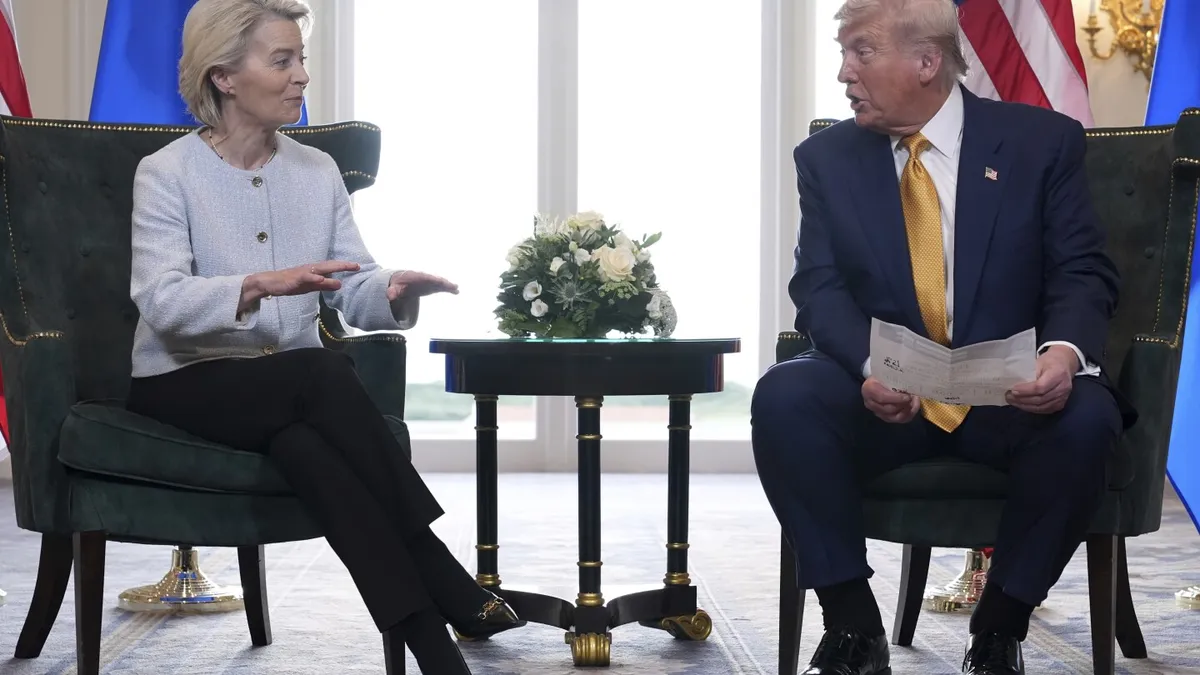
In a significant development for international trade, American and European Union officials announced a preliminary trade agreement on Thursday. This agreement introduces a 15% import tax on approximately 70% of European goods exported to the United States. However, notable categories such as wine and spirits and steel remain unaddressed, with further negotiations anticipated in these vital sectors. The officials emphasized that this document is merely “a first step in a process that can be further expanded to cover additional areas,” highlighting the ongoing discussions necessary to finalize the terms of the deal.
This newly released document spans just 3 1/2 pages and signifies a political commitment rather than a legally binding contract. Unlike traditional trade agreements that can extend to hundreds of pages, this concise format reflects the complexity of the world's largest bilateral trading relationship, which encompasses a staggering $2 trillion in annual transatlantic business activities.
Key provisions of the agreement include the implementation of a 15% tariff on most EU goods, while U.S. cars and various industrial products exported to the 27-member EU will incur a zero rate. Furthermore, certain exceptions apply to critical sectors like aircraft and aircraft parts, generic pharmaceuticals, and pharmaceutical ingredients, with possibilities for additional products to be considered in future talks. These terms aim to facilitate a smoother trading environment compared to the tariffs imposed during former President Donald Trump’s administration.
Howard Lutnick, the U.S. Commerce Secretary, expressed optimism regarding the deal, proclaiming that “the EU has agreed to open its $20 trillion market.” He categorized the agreement as a major victory for American workers and industries, asserting that “tariffs should be one of America’s favorite words.” However, European officials are facing scrutiny from businesses and member states concerned about the higher tariffs and the perceived concessions made by the EU.
European Commission President Ursula von der Leyen defended the deal, presenting it as a means to mitigate the higher U.S. tariff of 27.5% on EU cars. She indicated that the agreement could pave the way for further negotiations to exclude more products from the 15% tariffs. Notably, if the EU can implement necessary legislation by August 1, the lower tariff on cars will be applied retroactively, a commitment that EU officials are prepared to fulfill.
European Union’s chief trade negotiator, Maros Sefcovic, echoed von der Leyen's sentiments, emphasizing that the alternative to this agreement could have resulted in a trade war characterized by “sky-high tariffs.” While the deal aims to foster stability and confidence in transatlantic trade, economists warn that the increased tariffs could hinder economic growth and lead to elevated consumer prices.
One significant concern is the exclusion of wine and spirits from the tariff exemptions, which previously enjoyed zero tariffs since a 1997 agreement. Sefcovic mentioned that EU officials have yet to secure an exemption for these goods but remain hopeful for future discussions. Chris Swonger, President and CEO of the Distilled Spirits Council of the United States, pointed out that without a return to zero-for-zero tariffs, American distillers face uncertainty regarding future export and job growth.
Additionally, unresolved issues include proposals for a tariff rate quota for EU steel imports, which will require further negotiations. The 15% tariff represents a significant increase compared to pre-Trump tariff levels, which averaged in the low single digits. Importantly, these tariffs will be borne by American businesses, impacting their profits or resulting in higher prices for U.S. consumers.
The agreement also includes nonbinding commitments from the EU to purchase $750 billion in U.S. energy and for EU companies to invest $600 billion in the United States. These investments are contingent on assessments made by the European Commission regarding the spending plans of private companies.
As talks continue, both sides remain hopeful that the agreement will pave the way for a more balanced and mutually beneficial trading relationship in the future.